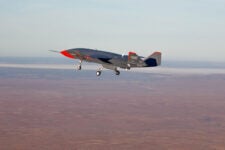
Deputy Secretary of Defense Kathleen Hicks tours the Nogales Border Patrol Station Mobile Surveillance Capabilities Site, Nogales, Arizona, June 11, 2021. (DoD/Brittany A. Chase)
WASHINGTON: The Pentagon’s next budget request will feature a more detailed breakdown of its investments on climate-related issues than ever before, with the department’s number two official saying she has put a “special emphasis” on climate solutions.
“These are not ideological issues of climate versus warfighting,” Kathleen Hicks, deputy secretary of defense, said Wednesday. “This is about ensuring we are resilient and capable for the warfighter of the future, and we’ll be making those investments.”
Climate change has been a hot potato for the department for years. While military planners will readily acknowledge concerns about how the climate could impact operations and bases in the future, political partisanship around the climate change issue means tackling it directly has been perilous at times, particularly during the Trump administration.
However, one of the first executive orders by President Joe Biden in January was a government-wide mandate to focus on climate change, which was followed swiftly by guidance from Defense Secretary Lloyd Austin to begin working the issue into department planning processes.
Hicks, who was speaking at the Defense News Conference, said that such work is well underway as the department puts together a strategic review of all its capabilities and global posture. She did not go into details about what might come out of such a review.
Still, it should be easy to get hints from the fiscal 2023 budget, and its associated five-year future spending projection, according to the deputy secretary. “You would see very clearly tagged out in the FY23 budget displays, you’d be able to track much better than the department has in the past, what its spending on climate,” she said.
Hicks also made her case for why the department needs to focus on the climate issue, especially when it is facing flat budgets for the foreseeable future. “Modernizing for the future now really means being resilient on climate,” she said.
In essence, Hicks laid out, there are three broad ways in which the department is being hit with climate change. The first is the amount of money DoD is spending — “billions of dollars in funds every year, just to make up for challenges to our installations, let alone the cost savings that we are not yet accruing when we don’t pursue greener approaches.” Those are dollars that could be going towards modernization efforts instead.
Second are supply chain concerns. She pointed out that as the commercial industry is shifting to greater reliance on green technologies, such as hybrid or purely electric vehicles, DoD could find itself unable to maintain and upkeep its fleets of vehicles if it does not keep up.
And lastly there’s the readiness concern. “We have black flag days” — days where physical training has to be paused due to air quality. “We can’t be ready sufficiently because we can’t fly, we can’t train in certain cases because of wildfires,” Hicks said. Compounding the issue, Hicks said military capabilities and personnel are being forced to assist with domestic climate emergencies like floods and wildfires, rather than preparing for an external threat.
“Those are just some of the areas that we’re really focusing our innovation efforts, and we do think it’s a whole of department approach [that] should pervade everything that we do,” Hicks concluded.
Major trends and takeaways from the Defense Department’s Unfunded Priority Lists
Mark Cancian and Chris Park of CSIS break down what is in this year’s unfunded priority lists and what they say about the state of the US military.


























